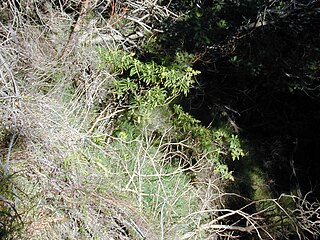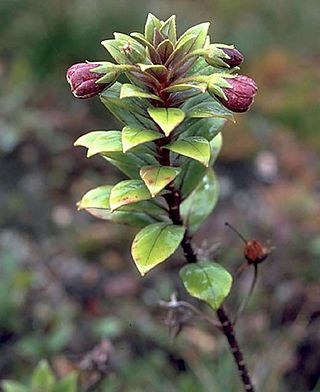Hawaiian hibiscus are seven species of hibiscus native to Hawaii. The yellow hibiscus is Hawaii's state flower. Most commonly grown as ornamental plants in the Hawaiian Islands are the non-native Chinese hibiscus and its numerous hybrids, though the native Hibiscus arnottianus is occasionally planted.

Argyroxiphium is a small genus of plants in the family Asteraceae. Its members are known by the common names silversword or greensword due to their long, narrow leaves and the silvery hairs on some species. The silverswords belong to a larger radiation of over 50 species, including the physically different genera Dubautia and Wilkesia. This grouping is often referred to as the silversword alliance. Botanist P. H. Raven referred to this radiation as "the best example of adaptive radiation in plants".

The Mauna Loa silversword, Argyroxiphium kauense, or Kaʻū silversword, is a rare species of flowering plant in the aster family. It is endemic to the eastern and southern slopes of Mauna Loa on the island of Hawaiʻi. A. kauense occurs in mountainous shrublands, bogs, and open mesic forest. The species is managed by the National Park Service and Hawaiʻi State Department of Forestry and Wildlife. It is a federally listed endangered species of the United States. There are three known populations remaining, for a total of fewer than 1000 individuals.
Melicope haupuensis is a species of tree in the family Rutaceae known by the common names Haupa Mountain melicope and Pacific pelea. It is endemic to the Hawaiian Islands, where it is known only from the island of Kauai. It is threatened by habitat loss. It is a federally listed endangered species of the United States. Like other Hawaiian Melicope, this species is known as alani.
Dubautia herbstobatae, the Na'ena'e or Keaau Valley dubautia, is an endangered species of shrub which is endemic to Oahu, Hawaii.
Cyrtandra paliku is a rare species of flowering plant in the African violet family known by the common name cliffside cyrtandra. It is endemic to Hawaii, where it is known only from the island of Kauai. The plant was first discovered in 1993 and it was described to science as a new species in 2001. At the time it was discovered there was only one population containing 70 individuals; a 2006 count revealed only ten plants remaining. It was federally listed as an endangered species in 2010. Like other Hawaiian Cyrtandra it is called ha`iwale.
Dubautia imbricata is a rare species of flowering plant in the family Asteraceae known by the common names bog dubautia and imbricate dubautia. It is endemic to Hawaii where it is known only from the island of Kauai. There are four known occurrences. Like other Dubautia this plant is known as na`ena`e.
Dubautia kenwoodii, the Kalalau rim dubautia, is an "extremely rare" species of flowering plant in the family Asteraceae. It is endemic to Hawaii where it is known only from the island of Kauai. Only one plant has ever been seen: the type specimen. A part of this plant was collected in 1991 and the individual was described as a new species in 1998. It was federally listed as an endangered species of the United States in 2010. Like other Dubautia this plant is known as na`ena`e.
Dubautia latifolia is a rare species of flowering plant in the family Asteraceae known by the common name koholapehu. It is endemic to Hawaii where it is known only from the west side of the island of Kauai. Like other Dubautia this plant is called na`ena`e.
Dubautia pauciflorula is a rare species of flowering plant in the family Asteraceae known by the common name Wahiawa Bog dubautia. It is endemic to Hawaii where it is known only from the Wahiawa Mountains on the island of Kauai.

Dubautia plantaginea is a rare species of flowering plant in the aster family known by the common name plantainleaf dubautia. It is endemic to Hawaii where it is the only member of the silversword alliance that is found on all six of the largest islands. Two of the three subspecies are rare and endangered. Like other Dubautia this plant is called na`ena`e.

Dubautia waialealae is a rare species of flowering plant in the family Asteraceae known by the common name Wai'ale'ale dubautia. Like other Dubautia this plant is called na`ena`e.
Labordia helleri, the Nā Pali coast labordia or Heller's labordia, is a rare species of flowering plant in the Loganiaceae family. It is endemic to Hawaii, where it is found only on Kauai. It is a federally listed endangered species of the United States. Like other Labordia species, this plant is known as Kamakahala.
Labordia pumila, the Kauai labordia, is a rare species of flowering plant in the Loganiaceae family. It is endemic to Hawaii, where it is found only on Kauai. It is a federally listed endangered species of the United States. Like other Labordia species, this plant is known as Kamakahala.

Lysimachia daphnoides is a rare species of flowering plant in the Primulaceae known by several common names, including Pacific loosestrife, lehua makanoe, kolekole lehua, and kolokolo kuahiwi. It is endemic to Hawaii, where there are only three populations remaining on the island of Kauai. It was federally listed as an endangered species of the United States in 2010.
Melicope degeneri is a rare species of flowering plant in the family Rutaceae known by the common names Kokee Stream melicope and Degener's pelea. It is endemic to Hawaii, where it is known only from the island of Kauai. It is a federally listed endangered species of the United States. Like other Hawaiian Melicope, this species is known as alani.
Myrsine linearifolia is a rare species of flowering plant in the primrose family known by the common name narrowleaf colicwood. It is endemic to Hawaii, where it is known only from the island of Kauai. There are 12 populations remaining, for a total of fewer than 200 plants. Like other Hawaiian Myrsine this plant is called kōlea. It is a federally listed threatened species of the United States.
Schiedea attenuata is a rare species of flowering plant in the family Caryophyllaceae known by the common name Kalalau schiedea. It is endemic to Hawaii, where it is known only from the Kalalau Valley on the island of Kauai. It is threatened by the degradation of its habitat. It was federally listed as an endangered species of the United States in 2010.
Schiedea kauaiensis is a rare species of flowering plant in the family Caryophyllaceae known by the common name Kauai schiedea. It is endemic to Hawaii, where it is known only from the island of Kauai. It is threatened by the degradation and destruction of its habitat. It was federally listed as an endangered species of the United States in 1996.

Polyscias flynnii is a plant species endemic to the island of Kauai in Hawaii. It is rare, found only in one population covering about 1 km2 in the Kalalau Valley. It is regarded as threatened. It is threatened by feral goats and non-native plant species in its habitat. It was federally listed as an endangered species of the United States in 2010.






